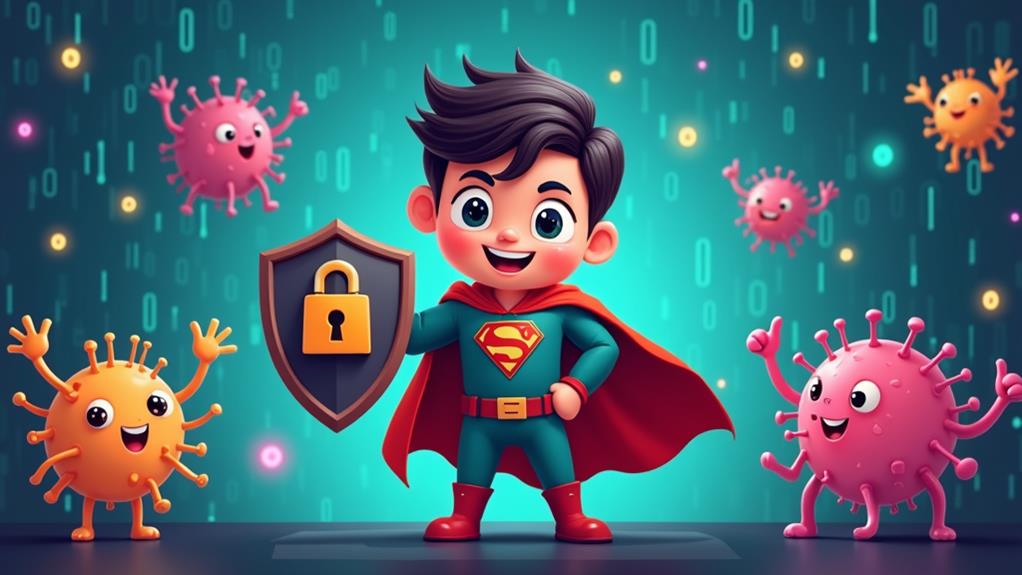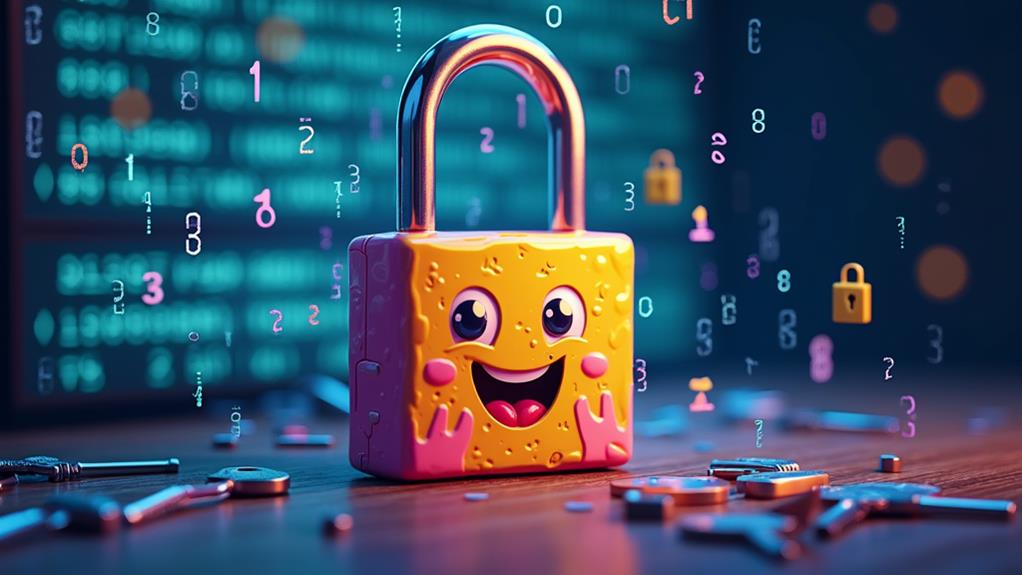
You can protect your digital life with a smile by mastering cybersecurity basics. Start by creating strong, unique passwords and enabling multi-factor authentication for your accounts. Keep your software up-to-date and learn to spot phishing attempts. Secure your Wi-Fi network by changing default settings and using strong encryption. Encrypt sensitive data and conduct regular security audits to identify vulnerabilities. Be cautious with unexpected emails or messages requesting personal information. By implementing these simple yet effective strategies, you'll substantially reduce your risk of falling victim to cyber threats. Dive deeper to access even more ways to safeguard your digital world.
Understanding Cyber Threats

Numerous cyber threats lurk in today's digital landscape, constantly evolving and posing significant risks to individuals and organizations alike. As you navigate the online world, it's vital to understand these threats and their potential impact on your digital life. Cybersecurity is no longer just an IT concern; it's a necessity for everyone who uses technology.
You're vulnerable to cyber threats in various forms, including malware, phishing, and man-in-the-middle attacks. Malware, short for malicious software, can infiltrate your devices through infected downloads, emails, or websites, wreaking havoc on your systems. Phishing attacks prey on your trust, disguising themselves as legitimate entities to steal your sensitive information. Man-in-the-middle attacks silently intercept your communications, potentially exposing your data to cybercriminals.
The frequency and sophistication of these threats are increasing at an alarming rate, with a reported 11% rise in cyberattacks in 2020 alone. To stay ahead of these evolving dangers, you must remain vigilant and proactive in your cybersecurity approach. By understanding these threats, you can better protect yourself and your digital assets from potential harm.
The Power of Strong Passwords
One of the most effective ways to protect yourself against cyber threats is by using strong passwords. In today's digital landscape, your passwords are the first line of defense against unauthorized access to your sensitive information. Creating a robust password isn't just about using a random combination of letters; it's about crafting a unique, complex string that's difficult for hackers to crack but easy for you to remember.
To create a strong password, consider using a passphrase—a sentence or series of words that's meaningful to you but nonsensical to others. Incorporate numbers, symbols, and both upper and lowercase letters to increase complexity. Avoid using personal information like birthdays or names, as these are easily guessable.
Remember to use different passwords for each of your accounts. This practice prevents a domino effect if one account is compromised. Consider using a password manager to securely store and generate complex passwords for you. By implementing these strategies, you're not just following best practices—you're actively innovating your approach to personal cybersecurity and safeguarding your digital identity.
Multi-Factor Authentication Explained

Security in the digital age goes beyond just creating strong passwords. Enter multi-factor authentication (MFA), a game-changing cybersecurity essential that's revolutionizing how we protect our digital assets. MFA requires you to provide two or more verification factors to access your accounts, making it substantially harder for cybercriminals to breach your defenses.
Think of MFA as a three-pronged shield: something you know (like a password), something you have (such as a smart card), and something you are (your unique biometric data). By combining these elements, you're creating a formidable barrier against unauthorized access. Implementing MFA can be as simple as using one-time passwords sent to your phone or leveraging cutting-edge authenticator apps.
The impact of MFA on your digital security is staggering. Studies show it can block up to 99.9% of account compromise attacks, effectively neutralizing threats from phishing, social engineering, and password-based intrusions. By embracing this innovative approach to cybersecurity, you're not just protecting your data – you're staying ahead of the curve in an ever-evolving digital landscape. Make MFA your new digital bodyguard and fortify your online presence against potential threats.
Keeping Software Up-to-Date
You can't afford to ignore software updates, as they're vital for patching security vulnerabilities and protecting your systems from cyber attacks. By enabling automatic updates, you'll guarantee you're always running the latest, most secure versions of your software without having to remember to do it manually. This simple step can dramatically reduce your risk of falling victim to data breaches and ransomware attacks, potentially saving your organization millions in damages and lost productivity.
Crucial Security Patch Benefits
Vigilance in the digital world begins with keeping your software up-to-date. By staying on top of the latest security patches, you're not just following best practices; you're actively strengthening your cyber defenses. These updates are your frontline protection against the ever-evolving threats in the digital landscape.
When you promptly install security patches, you're closing potential entry points for hackers. These updates address known vulnerabilities, effectively reducing your attack surface and safeguarding your sensitive data. In the fast-paced world of cyber threats, where criminals can exploit new vulnerabilities within 24 hours, timely updates are vital.
But security patches offer more than just protection. They often come bundled with performance enhancements, bug fixes, and exciting new features. By keeping your applications secure and up-to-date, you're not only fortifying your digital fortress but also ensuring peak performance.
Neglecting updates can have severe consequences, including data breaches, financial losses, and reputational damage. Don't leave your digital life vulnerable. Embrace the innovation that comes with regular updates, and make application security a top priority in your cybersecurity strategy.
Automatic Update Convenience
Staying on top of software updates can feel like a full-time job, but it doesn't have to be. Automatic software updates are your digital guardian angels, working tirelessly to safeguard your digital life. By enabling this feature, you're ensuring your devices receive the latest security patches, bug fixes, and performance enhancements without lifting a finger.
Think of automatic updates as your personal cybersecurity team, constantly fortifying your digital fortress against potential threats. They close vulnerabilities before hackers can exploit them, keeping you one step ahead in the ever-evolving world of cyber threats.
To make the most of this convenience, consider the following:
- Set your devices to update overnight while you sleep
- Enable automatic updates for all your apps, not just the operating system
- Check for manual updates regularly, just in case
- Restart your devices periodically to complete installations
- Keep your devices plugged in or well-charged for seamless updates
Embracing automatic updates isn't just about security; it's about accessing the full potential of your devices. With each update, you're not only protecting yourself but also gaining access to exciting new features and improvements. Stay current, stay secure, and let innovation flourish in your digital world.
Recognizing Phishing Attempts

Phishing's deceptive nature makes it one of the most common and dangerous cybersecurity threats. You need to sharpen your digital instincts to prevent cyber attacks that could compromise your personal information. Be wary of unexpected emails, messages, or calls requesting sensitive data or urging immediate action. Look for telltale signs like misspellings, unusual sender addresses, and generic greetings.
To help you identify potential phishing attempts, consider these red flags:
| Warning Sign | Example | Action |
|---|---|---|
| Urgent requests | "Act now or lose access" | Verify independently |
| Suspicious links | Shortened URLs or mismatched domains | Hover to preview, don't click |
| Requests for personal info | Social Security number, passwords | Contact company directly |
Stay ahead of cybercriminals by educating yourself on the latest phishing techniques. Enable multi-factor authentication on your accounts and use a password manager to generate strong, unique passwords. Remember, legitimate organizations won't ask for sensitive information via unsecured channels. When in doubt, contact the supposed sender directly using official contact information. By cultivating a healthy skepticism and staying vigilant, you'll substantially reduce your risk of falling victim to phishing scams.
Securing Your Wi-Fi Network
To secure your Wi-Fi network, start by changing your router's default username and password. Next, enable WPA3 encryption, the latest and most secure protocol for Wi-Fi networks. Finally, set up a guest network to keep visitors' devices separate from your main network, reducing potential risks to your sensitive data.
Change Default Router Settings
In light of the ever-growing cyber threats, securing your Wi-Fi network should be a top priority. The Importance of Cybersecurity in the Digital Age cannot be overstated, and changing your router's default settings is a vital first step. By taking a few simple actions, you'll substantially enhance your network's security and keep potential intruders at bay.
- Change the default admin password and network name (SSID)
- Disable WPS (Wi-Fi Protected Setup)
- Enable WPA2 or WPA3 encryption
- Set up a guest network
- Regularly update your router's firmware
Enable WPA3 Encryption
Enabling WPA3 encryption on your Wi-Fi network is a crucial step towards fortifying your digital defenses. This cutting-edge protocol offers unparalleled protection for your digital life, utilizing individualized encryption for each connected device. By implementing WPA3, you're not just securing your network; you're revolutionizing your approach to cybersecurity.
WPA3's innovative features make it a game-changer in the world of Wi-Fi security:
| Feature | Benefit |
|---|---|
| Individualized Encryption | Limits data access to single devices |
| 192-bit Encryption | Provides extra layer of security |
| Easy Configuration | Simple setup on compatible routers |
With WPA3, even if an attacker cracks your password, they'll only access data from their own device, not your entire network. This individualized data encryption is a powerful deterrent against hackers seeking to steal sensitive information.
The protocol's 192-bit encryption adds another layer of protection, making it extremely challenging for cybercriminals to decrypt your data. By enabling WPA3 on your router, you're taking a proactive step to safeguard your digital life. It's a simple configuration change that delivers a significant boost to your network's security, ensuring you stay ahead in the ever-evolving landscape of cyber threats.
Create Guest Network
While WPA3 encryption fortifies your main network, creating a guest network adds another layer of protection to your digital fortress. This separate network allows visitors to access the internet while keeping your primary network and devices safe from potential security risks. By setting up a guest network, you're fundamentally creating a digital moat around your castle, ensuring that any potential threats remain isolated.
Modern routers often come with built-in guest networking capabilities, making it a breeze to set up and manage. You'll create a second network with its own SSID and password, giving your guests a seamless internet experience without compromising your security. This innovative approach not only protects your main network but also helps prevent the spread of malware and viruses between devices.
- Isolates IoT devices, reducing vulnerabilities
- Prevents unauthorized access to your main network
- Simplifies internet access for visitors
- Keeps your personal devices and data secure
- Allows for easy management of network access
Data Encryption Basics

Data encryption forms the backbone of modern cybersecurity practices. It's the process of transforming your readable data into an indecipherable format, ensuring that even if intercepted, your information remains secure. You'll encounter two main types of encryption: symmetric, using a single key for both encryption and decryption, and asymmetric, employing a key pair for enhanced security.
When you're safeguarding your digital life, encryption algorithms like AES and RSA come into play. These powerful tools are measured in bits, with higher numbers indicating stronger protection. You'll want to aim for 128-bit or 256-bit encryption for peak security.
Data encryption isn't just for tech giants; it's a vital tool for your everyday digital interactions. Whether you're sending sensitive emails or storing confidential files, encryption protects your data both in transit and at rest. It's the invisible shield behind secure protocols like HTTPS and VPNs, working tirelessly to keep your information safe.
Regular Security Audits Matter
Your organization's security is only as strong as its weakest link, which is why regular security audits are crucial. These audits help you identify vulnerabilities, verify compliance with regulations like GDPR and HIPAA, and provide an exhaustive overview of your cybersecurity posture. By conducting regular security audits, you'll be able to detect and respond to advanced persistent threats and zero-day exploits, substantially reducing the risk of costly data breaches.
Regular security audits aren't just about ticking boxes in your Privacy Policy; they're about staying ahead of cyber threats and protecting your digital assets.
- They help you allocate resources effectively
- They verify compliance with industry standards
- They reduce the average cost of data breaches
- They identify and mitigate potential vulnerabilities
- They help detect and respond to advanced threats
Conclusion
You've now got the tools to safeguard your digital life. Remember, cybersecurity isn't just about tech—it's about your habits. Stay vigilant, update regularly, and don't be afraid to ask for help. Embrace these practices, and you'll be well on your way to a safer online experience. Cybersecurity might seem intimidating, but with a positive attitude and these simple steps, you're already ahead of the game. Keep smiling, stay safe!
As an Amazon Associate I earn from qualifying purchases.







